
Dacetonini, Myrmicinae, Formicidae, Hymenoptera, Insecta, Arthropoda, Animalia
John T. Longino
The Evergreen State College
Olympia WA 98505 USA
longinoj@evergreen.edu
31 March 1997
| Key to Costa Rican species of Strumigenys | Species List |
The dacetonines are a diverse lineage found throughout the world. Many species are known to be strictly predaceous, and all are assumed to be. Most of them have highly modified mandibles relative to the standard triangular mandible common to most other ants. Many have mandibles that are elongate, linear, and with opposing tines at the tip (convergent with other lineages such as Odontomachus in the Ponerinae). Others have elongate mandibles like serrated scissors. Others have serrated mandibles that curve ventrally. Most dacetonines are slow-moving, small, and very cryptic. Most are found in or under rotten wood, and in the leaf litter. Dacetonines are difficult to locate by visual search, but litter sifting followed by extraction in Winkler bags or Berlese funnels often yields abundant material.
The dacetonine genera currently known for Costa Rica are Acanthognathus, Glamyromyrmex, Neostruma, Smithistruma, Strumigenys, and Trichoscapa. I avoid giving details of generic definitions here, because Barry Bolton of the British Museum is currently revising "smithistrumiform" dacetonines, and the generic definitions will change dramatically.
Key to Costa Rican Strumigenys (first couplet)
This key relies almost entirely on the key in Brown (1962). The figures below illustrate the habitus of Strumigenys, and some of the main characters used in species-level identifications.

1a. Apical fork of mandible without distinct intercalary teeth or denticles (intercalary teeth can be difficult to see; select specimen in which the tips of the mandibles are somewhat separated and tilt specimen to anterior view of mandibles; backlighting often helps) : 10
1b. Apical fork of mandible with one or more intercalary denticles (several common species have the apical fork relatively small, with two tiny intercalary denticles that are difficult to see; often the mandibles are closed on specimens, and the intercalary denticles impossible to see): 500

10a. Mandible without preapical teeth or denticles: 20
10b. Mandible with 1 or 2 preapical teeth and/or denticles: 250

20a. Postpetiole large and convex, its dorsum smooth and shining; setae on gaster straight; larger, more robust species: consanii
20b. Postpetiole small, its dorsum densely punctulate and opaque; setae on gaster flagelliform, bent, coachwhip-like; smaller, more slender species: elongata
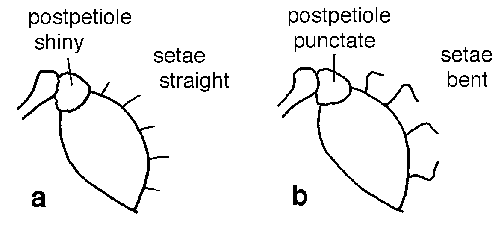
250a. First segment of gaster margined for its full length on each side by a strong, raised dorsolateral ridge: marginiventris
250b. First gastral segment smoothly rounded dorsolaterally, without raised margins apart from the basal costulae: 370
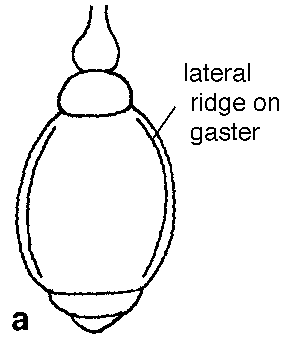
370a. Head with a strong concavity anterior to each eye, and thus appearing constricted in full-face view; humeral tubercles large and produced: precava (keys twice due to variability in intercalary teeth)
370b. Head parallel-sided or gently tapered in front of eyes; humeral tubercles or angles small, not produced: 375
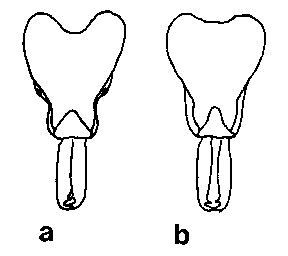

375b. Smaller species with mandibles not so long; combined length of head + mandibles < 1.10mm: 438
438a. Compound eye anteriorly detached, i.e., bounded in front by a narrow cleft or notch in the ventrolateral margin of the head: rogeri
438b. No preocular notch in ventrolateral border of head: carinithorax

500a. Apical fork of mandible with a single intercalary tooth or denticle, either separate or occurring as a spur on the inner side of the ventral tooth: 510
500b. Apical fork of mandible with 2 intercalary denticles: 750

510a. Mandible with no preapical teeth, or with a single preapical tooth or denticle, or with a preapical tooth or denticle plus another minute denticle proximal to it: 520
510b. Mandible with 2 well-developed preapical teeth: 635
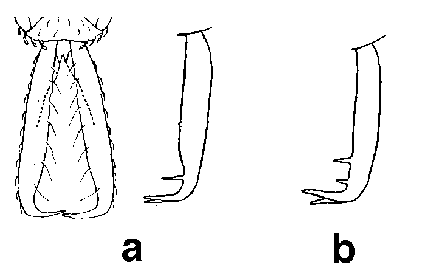
520a. Mandible without preapical teeth or denticles: 530
520b. Mandible with a preapical tooth or denticle, or both: 570
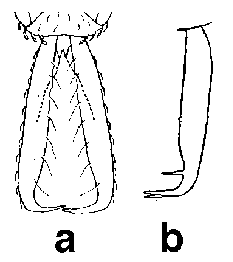
530a. Petiole claviform, the node only feebly differentiated from its anterior peduncle; gastral hairs mostly stiff, spatulate: ludia
530b. Petiolar node with a distinct anterior face, set off from its anterior peduncle; gastral hairs either stiff but filiform, or long, finely flagelliform, coachwhip-like: 554

554a. Erect gastral hairs stiff, filiform, not coachwhip-like; head relatively wider (CI 82): JTL-002
554b. Erect gastral hairs long, finely flagelliform, coachwhip-like; head relatively narrower (CI 71-74): micretes (keys twice due to variability in preapical denticles)
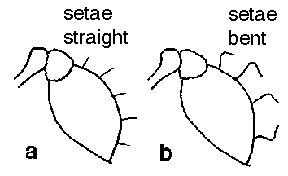
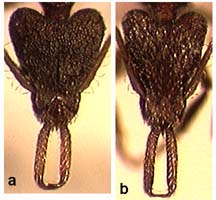
570a. Face strongly flattened, largely concave, margined laterally by frontal carinae: JTL-008
570b. Face convex: 578

578a. Ventral ends of propodeal lamellae at most rounded or bluntly angulate, not dentiform: 580
578b. Propodeal teeth large and acute, matched on each side below by a metasternal tooth of nearly the same size and shape arising from the ventral end of the infradental lamella: trinidadensis (keys twice due to variability in preapical denticles)

580a. Long fine flagelliform hairs on nodes of petiole and postpetiole and on gastral dorsum very numerous, too many to count: 584
580b. Long flagelliform hairs of nodes and gastral dorsum much fewer, at most about 34 on gastral dorsum: 600
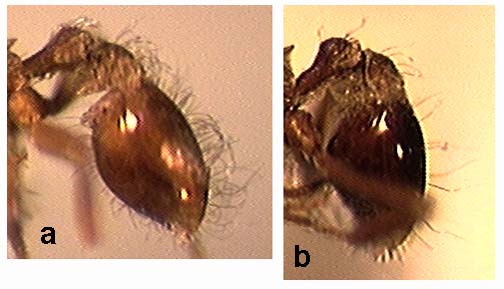
584a. Top of first gastral segment largely smooth and shining, with longitudinal striae confined to anterior 1/4 or less: 587
584b. Top of first gastral segment finely longitudinally striate throughout, opaque: lanuginosa
587a. Eye with approximately 20 facets; basal costae of gaster fine, numerous: JTL-010
587b. Eye with fewer than 10 facets; basal costae of gaster coarse, few: JTL-011
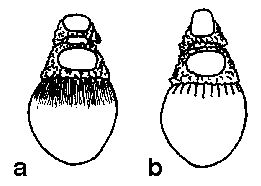
600a. Head with a strong concavity anterior to each eye, and thus appearing constricted in full-face view; humeral tubercles large and produced: precava (keys twice due to variability in intercalary teeth)
600b. Head parallel-sided or gently tapered in front of eyes; humeral tubercles or angles small, not produced: 605


605a. Smaller species, with mandibles < 0.42mm long; head length 0.64mm or less; head broader (CI>75): nevermanni
605b. Larger species, with mandibles 0.42mm or longer; head length 0.69mm or more; head narrower (CI 75 or less): 618

618a. Gastral dorsum with setae stiff, straight, slightly thickened: JTL-003
618b. Gastral dorsum with setae long, thin, flagelliform: micretes (keys twice due to variability in preapical denticles)

635a. Large species with massive head and short, heavy mandibles (head width > 0.85mm, MI 50 or less): godmani
635b. Smaller species, with more typically proportioned head: 640
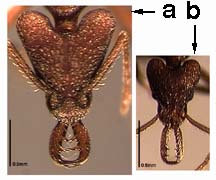
640a. Gastral dorsum finely longitudinally striolate, sericeous-opaque, with very abundant, fine, erect flagelliform pilosity: trinidadensis (keys twice due to variability in preapical denticles)
640b. Gastral dorsum with either sculpture or pilosity or both different from the above: 645
645a. Mandibles longer than the head (MI 109-123): cordovensis
645b. Mandibles shorter than head: 697
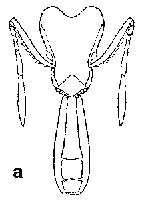
697a. Propodeal lamellae without dorsal teeth or angles, ventral angle present and prominent; basal costulae on gaster short to absent, less than 0.05mm long along midline: biolleyi
697b. Propodeal lamellae angulate or toothed both above and below; basal costulae on gaster longer, approximately 0.10mm or longer along midline: 725
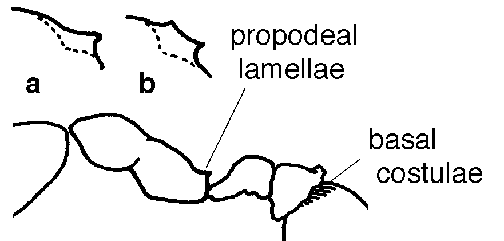
725a. First gastral tergum with numerous short, strongly spatulate setae; head narrow (CI 65): borgmeieri
725b. First gastral tergum nearly nude, the few scattered setae long and flagelliform; head broader (CI > 80): smithii
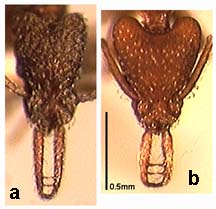
750a. Mandible with a single small preapical tooth; no additional preapical teeth or denticles on inner border: louisianae
750b. Mandible with 2 or more preapical teeth and/or denticles: 875

875a. Mandible with at most 2 preapical teeth and/or denticles: 885
875b. Mandible with 3 or more preapical teeth and/or denticles: 938

885a. Mandible with 1 preapical tooth and a single additional minute denticle near the apical third of the mandibular length; gastral dorsum with abundant, stiff, erect, spatulate hairs; sculpture of gastral dorsum reticulate-striate, opaque: mixta
885b. Mandible with 2 well-developed preapical teeth; gastral dorsum with at most a few long-flagelliform hairs (although ground pilosity may be abundant and conspicuous); sculpture of gastral dorsum variable: 912

912a. Dorsum of basal gastral segment with longitudinal costulae only at base, otherwise smooth and shining; short, spatulate, reclinate ground hairs of gastral dorsum abundant and conspicuous: tococae
912b. Dorsum of basal gastral segment longitudinally striolate for its full length; reclinate ground hairs of gastral dorsum obsolete or apparently so: fairchildi
938a. outer margins of mandibles relatively bowed; head length 0.75; mandibles relatively long (MI 67): JTL-005
938b. Outer margins of mandibles relatively straight; head length < 0.60mm; mandibles relatively shorter (MI 60 or less): 943

943a. Mandibles short and thick (MI < 56); robust species, worker HL mostly > 0.48mm: 948
943b. Mandibles longer and slender (MI 56 or more); smaller species, worker HL mostly 0.48 or less: 969

948a. Mandible with exactly 3 small preapical teeth; ground pilosity of head nearly or quite obsolete: trieces
948b. Mandible with > 3 preapical teeth or denticles; ground pilosity abundant and conspicuous on head: subedentata

969a. Ventral spongiform appendages of postpetiole small but distinctly developed; gastral dorsum predominantly smooth and shining: gundlachi
969b. Ventral spongiform appendages of postpetiole absent; gastral dorsum with fine, mostly opaque reticulation: eggersi

Literature Cited
Brown, W. L., Jr. 1962. The Neotropical species of the ant genus Strumigenys Fr. Smith: Synopsis and keys to the species. Psyche 69:238-267.